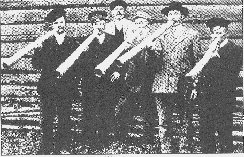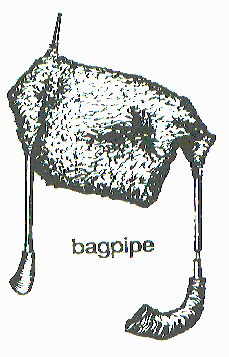
Horn players from Dirvonakiai, Birzai district, 1912




Lithuania's instruments are quite similar to those of its Baltic neighbors and also bear some resemblance to those of the Slavic and Germanic peoples. They are quite uniform throughout Lithuania with the notable exception of northeastern Aukstaitija. Lithuanian folk instruments can be classified into four groups: string, wind, percussion and idiophonic.
 Kankles are the oldest and most archaic of Lithuanian string instruments. They were thought to be associated with death. Lithuanians believed that in order to make sonorous kankles, the wood from which they were crafted had to be cut from a mature forest on the day that a loved one died. As the household mourned, the wood acquired depth and soul. Playing kankles was very much like meditating and was thought to protect the musician from death, disease and accidents. In general, only men played kankles and crafted their own instruments. In order to pass on old traditions, they explained the secrets of kankles crafting and playing to younger generations.
Kankles are the oldest and most archaic of Lithuanian string instruments. They were thought to be associated with death. Lithuanians believed that in order to make sonorous kankles, the wood from which they were crafted had to be cut from a mature forest on the day that a loved one died. As the household mourned, the wood acquired depth and soul. Playing kankles was very much like meditating and was thought to protect the musician from death, disease and accidents. In general, only men played kankles and crafted their own instruments. In order to pass on old traditions, they explained the secrets of kankles crafting and playing to younger generations.
The body of the kankles has a trapezoidal form and is carved from a single piece of linden, maple, ash or alder wood. The instrument's wider end is cut diagonally. A fir wood top decorated with four-pointed, five-pointed or six-pointed stars and other patterns is fastened to the body. A metal bar to which metal or catgut strings are anchored was set in the narrow end. Wooden pegs fitted in the wide end regulate the tension of the strings whose number varies from five to twelve.
Kankles were played using the fingers or a wooden pick. They could be classified into three types according to number of strings, playing technique and repertoire: northeastern Aukstaitija (type I), western Aukstaitija and Zemaitija (II) or Suvalkija (III).
Another ancient Lithuanian string instrument, the pusline, is made from a tree branch bowed by a catgut or waxed string. A dried, inflated pig's bladder containing a handful of dried peas is fitted between the branch and string. A bow is then drawn across the string to produce a bass sound.
There existed an astonishing array of wind instruments in Lithuania. Shepherds often played whistles, svilpas (simple flutes) and birch bark strips. The lamzdelis is an instrument similar to a recorder made of wood or bark. It has three to six sound regulating apertures. Lamzdeliai were used by shepherds to play intricate melodies called tirliavimai, raliavimai, ridavimai or to play folk songs or dances.
 Lithuanian reed instruments include the sekminiu ragelis and birbynes (reed-pipes) made of straw, wood or bark. The goathorn was an instrument popular among herdsmen. A man who played this instrument was held in high regard. Its repertoire was very diverse including tirliavimai melodies, folk songs, marches and dances.
Lithuanian reed instruments include the sekminiu ragelis and birbynes (reed-pipes) made of straw, wood or bark. The goathorn was an instrument popular among herdsmen. A man who played this instrument was held in high regard. Its repertoire was very diverse including tirliavimai melodies, folk songs, marches and dances.
The herdsman's horn is made from wood or wrapped bark. It was a signaling instrument used to help drive animals and to announce milking times. Some skillful herdsmen were able to play folk songs and dance melodies using this instrument.
Skuduciai, ragai and daudytes occupied a unique niche among Lithuanian wind instruments. They were found only in northeastern Aukstaitija and are described in the section dealing with that region.
The most popular percussion instrument in Lithuania was the drum. It was used to convey news, to invite people to gatherings, at burials, and later to accompany dances. Smaller drums with goat or dog hide covering one end were also popular. These were beat with the hands or with a stick.
Idiophonic instruments also conveyed messages. Tabalas consisted of one to three boards hung from trees, granary or bathhouse walls. Rhythmical signals beat on these devices announced herding times, emergencies and village gatherings. The dzingulis was used by wedding announcer to summon the guests. This instrument consisted of a one or two-forked branch decorated with rue sprigs and ribbons upon which bells were hung. It was struck on the floor to produce sound. The kleketas, terksle, and skrabalai were shepherds' instruments used to drive animals, scare birds and play games.
 The bagpipe appeared in Lithuania around the 16th century and today only survives near the eastern borders. The bag was sewn from sheep or calf hide; two pipes (melody and drone) and a mouthpiece were attached to it. The bagpipe enlivened weddings and tavern festivities.
The bagpipe appeared in Lithuania around the 16th century and today only survives near the eastern borders. The bag was sewn from sheep or calf hide; two pipes (melody and drone) and a mouthpiece were attached to it. The bagpipe enlivened weddings and tavern festivities.
Other popular imported instruments include the Jew's harp, the dulcimer and the fiddle. Around the 19th century, drums with cymbols and the basetle became popular. The latter instrument is similar to a contrabass in form, but with only three strings.
 The late 19th century heralded the appearance of new varieties of accordions in Lithuania: with one row of keys, two rowed German accordions, bandonions, concertinas, Petersburg accordions and harmonicas. Mandolins, balalaikas, guitars, clarinets and cornets appeared in the 20th century.
The late 19th century heralded the appearance of new varieties of accordions in Lithuania: with one row of keys, two rowed German accordions, bandonions, concertinas, Petersburg accordions and harmonicas. Mandolins, balalaikas, guitars, clarinets and cornets appeared in the 20th century.
Folk music ensembles had long been popular in Lithuania. They sometimes consisted of a single instrumental type and sometimes of several. Mixed ensembles appeared in historical records as early as the 16th century. Village folk music ensembles were divided into two historical categories: old (before the early 19th century) and new (after the mid 19th century). Old groups performed using archaic musical instruments, such as kankles, lamzdeliai, birbynes. Fiddles were used as well. New groups replaced many of the archaic instruments with imported ones, such as accordions, clarinets and cornets. Village ensembles of different ethnographic regions varied.



"LITHUANIAN ROOTS", Edited by Rytis Ambrazevicius